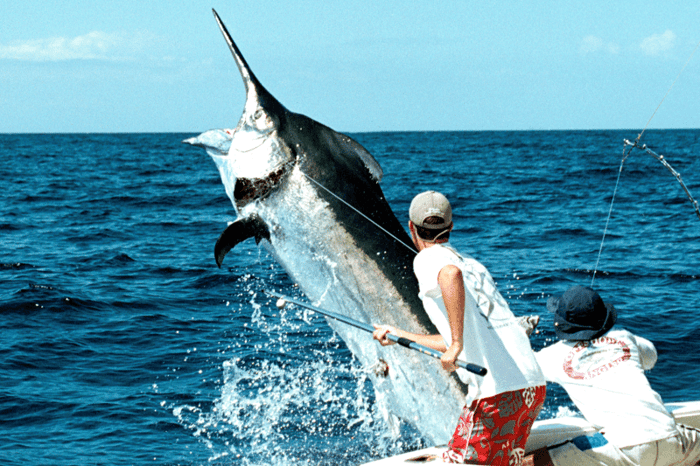Cape Verde is a wide archipelago of ten volcanic oceanic islands located 14 degrees north and about 200 miles west of West Africa. The arid, inhospitable islands were discovered in the 15 century and colonized by the Portuguese. Now the total population is 600,000 people who celebrated their 50th anniversary of independence from Portugal. These islands and sea mounts provide essential habitat for bait fish and large predators.
Receiving a very kind invitation from Flint Besecker to fish in Cape Verde, I was keen to see what it was like after my last expedition 26 years ago. With Bill Boyce, we had organized a charter in 1999 on the “Hooker” and the “Madam”. The aim was to film blue marlin free swimming in a region where there were lots of fish. This was before fishing the FADs became deployed in many locations.
We knew it would be rough conditions, particularly in the “wind acceleration zones” in the channels between the mountainous islands. Flint was working with the Atlantic Fishing Charters company and with his friend Larry Cobado, we were on the 37 Bertram “Smoker”, with Captain Luis Roque, mates Martini Palmer and Jah Jah Moreira from Mendilo. Flint had sponsored 4 mini PATs (archival tags) from the IGFA to be deployed this week in the IGFA’s Great Marlin Race, a worldwide angler science project to learn more about the migrations and habitat use by different billfish species. The data analysis is conducted by Dr. Barbara Block at Hopkins Marine Station, Stanford University.
Our first day began trolling across the main channel aka “the washing machine” from Sao Vicente to Santo Antao. Once in the lee of the wind we trolled along the deep edge close to shore, a place appropriately named “Jurassic Park” with high, arid peaks in the background. We were trolling two large teasers short and two lures on the riggers with hooks on 130# reels. The main focus was on pitching baits to marlin on the teasers. Baits were a big ballyhoo and chugger on the right, a bullet bonito on the left on 400# leaders. The standby pitch rig with a heavier 700# leader was always at the ready for Big Julie. Larry caught the first marlin on a lure, 250# blue right off the village of Terrafal. Another bigger marlin followed the left teaser without biting anything.
Bill Boyce joined us so we decided to stay the next day and fish all day off Santo Antao, and booked comfy rooms in a small guest house fittingly called The Boabab, with the huge African tree of the same name at one end of the garden. The crew stayed on the “Smoker” on a mooring just off the black shingle beach. In the morning we were taken to the boat through the gentle surf by a couple of local fishermen who paddled us out into deeper water. As we left the lures went out immediately, we were already in the zone. Martini told me the story of the giant 1,370 pound blue marlin they caught two years ago in the same spot. It was the second largest Atlantic blue ever recorded on rod and reel.
We spent the day looking for the signs of fish, and encountered groups of Atlantic spotted dolphins, some rare rough tooth dolphins, pilot whales and the occasional whale sharks. Luis fished anywhere between 100m out to 2000m. There were several other local charter boats in our area and everyone was keeping the boats updated. Bill and I took a lot of photos of the marine life and of the one small blue marlin Flint caught which was tagged with a mini PAT. The reports from Sao Nicolao, 70 miles to the southeast were good, particularly for the “sonar boats”. In the afternoon we trolled north close in to the shelf, up towards another small isolated village called Monte Trigo. Steep cliffs and volcanic peaks rose high above us. There were wonderful rock formations, layers of ash and lava tubes in all the earth tones imaginable. Several pairs of tropic birds nested in the cliffs. They are a beautiful, delicate, white seabird with long tail feathers. It is a cosmopolitan species in the tropics and a bird I love to paint.
We went further north into the wind line in area that Luis would fish from time to time with good results. Further out 18 miles was Banco Noroweste. One charter boat that was fishing there reported 4/6 mostly on small marlin. We were thinking of going there later in the week. The average wind speed offshore was 30 knots every day.
We did not “make contact” the following day, though we saw pilot whales, rough tooth dolphins and other species of dolphin. Luis worked around them a lot, as often blue marlin linger where there is activity. Bill Boyce stayed busy with doing interviews with the crew for his story for Marlin Magazine.
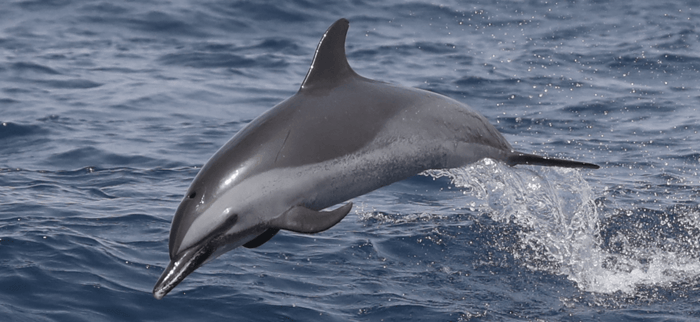 A dolphin spotted at the Cape Verde Blue Marlin Expedition
A dolphin spotted at the Cape Verde Blue Marlin ExpeditionBill’s last day with us was slow again, and finally had a bite, that became unbuttoned, as we crossed the channel heading back to Mindelo. We had enjoyed several of the waterfront restaurants in the thriving port city.
Rather than head south east to Sao Vicente, where the bite had slowed a bit, Luis decided to head back to Santo Antao for the next few days. We went straight to the closest fishing ground off San Pedro’s iconic lighthouse, visible in the back ground. Not raising any fish there after a couple of hours, we headed north again. Crossing the channel, Larry caught an active fish of 200#, to break our slow streak. Many of this marlin’s jumps cleared 30 feet horizontally across the windy surface. The marlin was tagged with a mini PAT. We had a busy afternoon, raising a fish on the right teaser, pitched and Flint caught a 150# blue in short order. Then we raised another marlin and pulled the hook on a lure.
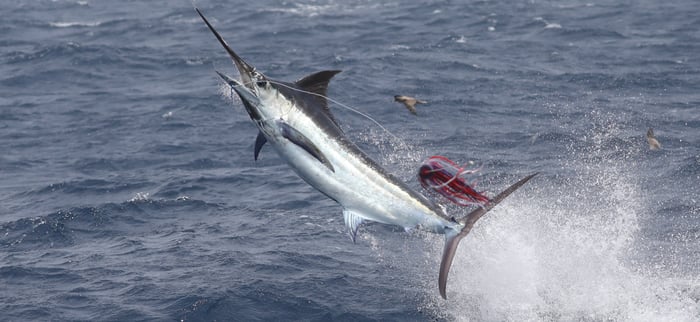 One of the blue marlins that were tagged and released at the Cape Verde Blue Marlin Expedition
One of the blue marlins that were tagged and released at the Cape Verde Blue Marlin ExpeditionMartini spotted a whale shark. Jumping in to action I went for snorkel with the largest of all fish. This big female was in the range of 45 feet long, swimming leisurely close to surface accompanied by some pilot fish. Armed with my Go Pro I got some great content for our marine science education initiative. The water temperature was cool at 73 F.
Back at the beach off Terrafal, the local fishermen were catching bait for fishing the next day. On the beach other fishermen were cleaning a couple dozen large rainbow runners, one of which we had that evening beautifully prepared for dinner at Lobo’s restaurant. Other fishermen were boxing up split, dried ballyhoo, that would be taken to Mindelo for sale. We resumed our stay on the Boabab where the breakfast was classic island cuisine.
Just off the shore that morning, local fishermen were using a small seine net to catch more ballyhoo. These were split like a kipper and dried in the sun. We got our paddle Uber to the “Smoker” and lines were out within 30 seconds. Luis’ plan for the day was to troll 20 miles to Banco Noroweste. We crossed from the lee and into the wind line trolling in the trough, the ENE wind was brisk. At 8.15am, Jah Jah and I were in the cockpit watching the spread, commenting on the sea conditions when there was a big fish swirl on the right teaser. Throwing the ballyhoo pitch, the marlin crossed the wake and came up on the left teaser, then crossed the wake again head, dorsal and shoulders out to eat the ballyhoo. I came tight on the fish quickly, Martini exclaimed the fish was over 800#. The one we had been waiting for.
Larry was in the chair on this one as the marlin stripped line off the reel and turned down sea, thankfully. Luis was backing down sea at full speed, I was in position to get any jump shots, but the fish jumped several hundred yards away, a difficult shot given all the moving parts. After 15 minutes of chasing the fish, Martini had the leader, releasing it as the fish moved away, half jumping, throwing a lot of white water. Even at this close range it was hard to get a clear photo shot of the marlin as the head shaking put up so much white water. It looked like a small boat planing on the surface. Some of my photos show the massive girth of such a large blue marlin. This continued for several minutes, every time Martini had the leader he had to dump it quickly. Lessons on how to wire big fish. We also wanted to tag this fish, not break it off.
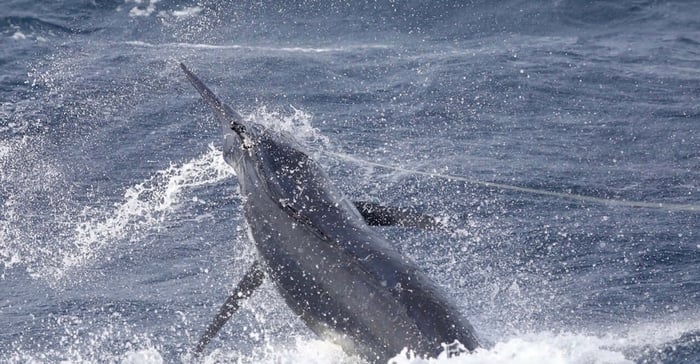 Big Blue Marlin on the line at the Cape Verde Blue Marlin Expedition
Big Blue Marlin on the line at the Cape Verde Blue Marlin ExpeditionFinally the marlin was up on the starboard side still heading down sea and I had a clear tag shot, deploying the mini PAT in the right shoulder of the massive fish. Perfect release. The fish we had all been waiting to see.
We continued trolling toward the bank, where another boat the Merritt boat “Catch” had already raised several marlin. There were lots of birds working the area famous for big wahoo, yellowfin tuna and blue marlin. On our last expedition on the “Hooker” we had teased several marlin in this location, filming them free swimming with great success in spite of the rough conditions.
We caught a small blue on a lure, then had a double in the spread which we missed, then raised another blue, all small fish. At 2pm we decided to troll in the trough back towards the area called “Middle Ground” where we released the big marlin earlier, then returned to Santo Antao. Luis found a group of four large beaked whales, a very rare large bodied cetacean known for deep dives. Soon after we were in a widespread school of feeding spotted dolphins. Mixed in with these was a very rare albino dolphin, a sight I would remember and paint at a later date. We had a shot at another small marlin on a lure but pulled the hook.
On day 7, we fished in the same area and had seen half a dozen very large whale sharks. After releasing another small blue of 150# that Larry caught on a lure we found a big shark close to the surface. I jumped in with mask and fins, Go Pro as well and spent 15 minutes with the cooperative shark that was accompanied by many large white remoras and some pilot fish. What an experience. It was barely swimming and was clearly interested in the boat. The visibility was awesome, probably 200 feet.
For our last day we headed back to the “Middle Ground” area in the wind line. At 8.25am we had a hard bite on the left rigger lure, the fish was peeling line very fast off the reel. It soon slowed and I knew the fish had turned and was coming at the boat. It screamed past the starboard side just beneath the surface, Luis chased down sea at first and then turned to chase in reverse, Flint doing a great job on the reel.
The jumps were far away, and the fish was tired at the boat, I was able to deploy the last mini PAT perfectly in the 400# marlin. With four tags deployed on a range of sizes of blue marlin, therefore it was mission accomplished. Luis worked the area for most of the day, and we continued to see a lot of dolphins, and more whale sharks, some close to the boat. We, at the Guy Harvey Research Institute, had satellite tagged many whale sharks with our Mexican research team in the Yucatan, the western Caribbean, with great results for the last 7 years. I could see a research project hatching here.
Back in Mendillo that evening Luis said the boats in their company were going to be fitted soon, with the sonar which many of the private boats had been using with great success. From all the accounts and catch data I had seen showed that boats with the Omni sonar were releasing three times more billfish than boats that did not have sonar.
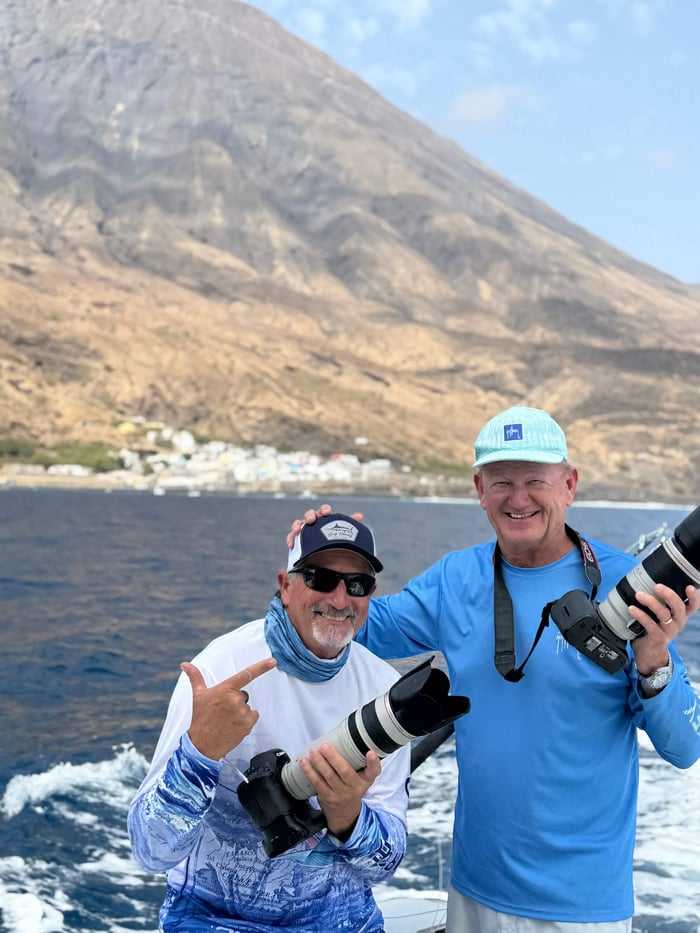 Bill Boyce and Guy Harvey wearing Guy Harvey sun protection fishing shirts at the Cape Verde Blue Marlin Expedition
Bill Boyce and Guy Harvey wearing Guy Harvey sun protection fishing shirts at the Cape Verde Blue Marlin Expedition Please support the Guy Harvey Foundation’s efforts in fishery research (178 published papers), conservation and our marine science education initiative for children.
Tight lines and good luck.
Guy Harvey


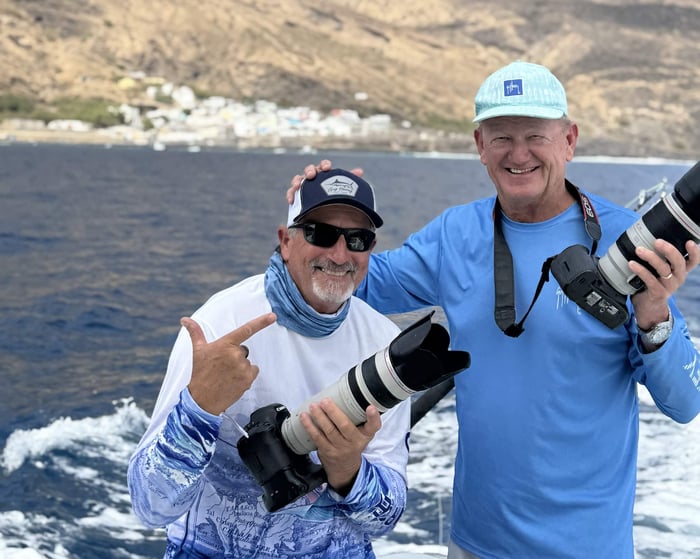
.jpg)

